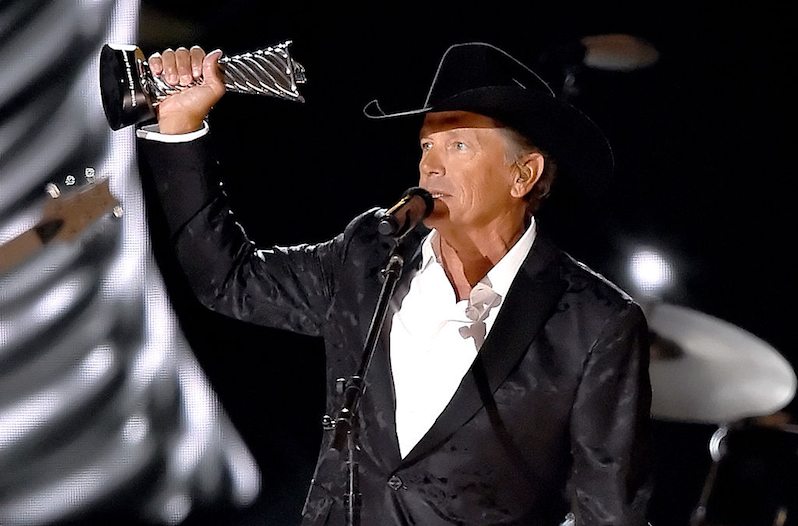In a few days, some of country music's biggest stars gather in Las Vegas to celebrate their format and hand out trophies. One of two major country award shows, the 52nd Academy of Country Music Awards takes place in a swanky new arena on the Las Vegas strip.
Videos by Wide Open Country
But does it matter?
The ACM Awards comprises one of two major country award shows every year. They usually take place in April, while the Country Music Association hands out its awards in Nashville in November. Both shows get the national TV treatment. And both shows also crown an Entertainer of the Year, along with other auspicious titles like Song of the Year and Album of the Year.
That's a lot of back-patting all for one genre. And while both the ACMs and the CMAs carry a rich tradition and history, many fans feel they don't represent what they're supposed to anymore. Do these country award shows fairly capture the essence of country music? Do the "best" artists really get recognition?
A Brief History
The Country Music Association first laid roots in Nashville in 1958. With a mission of promoting and furthering country music around the world, the CMA didn't originally hand out any annual awards.
But after about six years, a group of artists and executives felt the CMA didn't give a fair shake to country music coming from outside of the Nashville sphere. They formed a new organization in Los Angeles in 1964, calling it the Country & Western Music Academy (later known as the Academy of Country Music).
The ACM's goal at the time felt a little more focused: show love and bring awareness to country music from the western 13 states. And they knew the best way to do that was hand out some awards. So the ACM formed its first award ceremony in 1966. Naturally, country artists largely from California like Merle Haggard and Buck Owens dominated the awards.
Not to be outdone, the CMA created its own awards one year later. Neither show received much attention at first, but the second annual CMA Awards received more attention when the taped version of the ceremony garnered television interest. From 1969 onwards, the CMA Awards found a live national television audience, while the ACM Awards received the same attention beginning in 1972.
How They Work
Both the ACMs and CMAs function similarly, with a few different wrinkles here and there. Artists and entertainment industry professionals join both organizations for an annual fee ($75 for the ACM, $100 for the CMA). Then every year, the voting bodies go through a multi-round process to nominate and vote upon award winners.
And that's precisely why both award shows feel so homogeneous now. Essentially, the same large group of professionals and artists vote for both awards. They take place at different times of the year, and thus affect the marketing and album cycles differently. But marketing plays a huge role in who gets a nomination.
Artists and their teams usually send out music and swag to all the voting members in order to attract more attention. And naturally, the folks who can afford to spend tens of thousands of dollars have a better shot at getting nominated. Once you're in the circle, nominations come more easily.
It's why artists like Maddie & Tae and Big & Rich both scored Vocal Duo of the Year nominations at the ACMs, despite not having anything really going on since releasing music in 2015 and 2014, respectively.
Do They Matter?
That's the big question, after all. And are they representative? When living legends who still actively tour and release music (like Willie Nelson and Loretta Lynn) don't get any nominations, what chance do smaller but more critically lauded artists have? The ACM briefly let fans select the "Entertainer of the Year" and three new artist categories, but changed after artists complained the whole process boiled down to an internet voting spam competition.
For most labels, the television aspect of the ACMs and CMAs makes them a justifiable marketing cost — if you've got the budget. But that means for a large chunk of the country fanbase, the shows are a massive marketing gimmick wrapped in an award facade. They don't really bring new music or other acts to the table.
Once in a blue moon, somebody like Chris Stapleton gets up on the stage and instantly connects with millions of new people. And in those moments, these shows really do achieve their original purpose. The shows can change the lives of individual artists in the right moments.
And there's not a country artist out there who doesn't feel some sense of pride in the ACM or CMA win. But let's not pretend the whole point of these shows now isn't to move music and sell tickets. And let's not also pretend the audience Stapleton floored didn't originally tune in to watch Blake Shelton and Sam Hunt (or Justin Timberlake).
https://www.youtube.com/watch?v=bNsofGKws9g
Plot Twist
In essence, no, the CMAs and ACMs don't fairly capture the country music world. They represent a large commercial faction of the genre. That's why the Americana Music Honors and Awards, the Ameripolitan Music Awards and the Texas Regional Radio Music Awards now exist. They formed out of a desire to honor others who don't fall in the ACM/CMA box.
But the overall ends justify the means.
The televised award shows bring in a huge chunk of money for each organization. And, in turn, both the CMAs and ACMs turn that change into charity. Organization like the ACM Living Lives and the CMA Foundation pour millions of dollars into education, health and philanthropy.
Without these shows, neither the CMA nor ACM would be able to conduct the amazing public outreach they achieve on a yearly basis. And to the thousands of lives they change yearly, that matters a whole lot.




